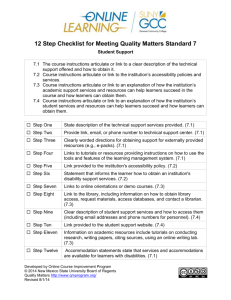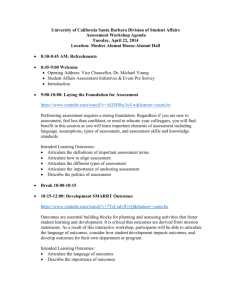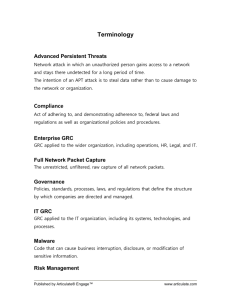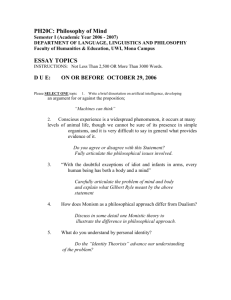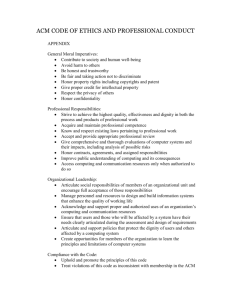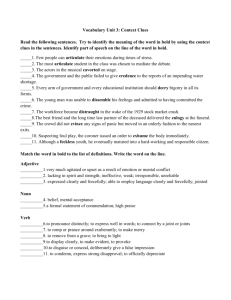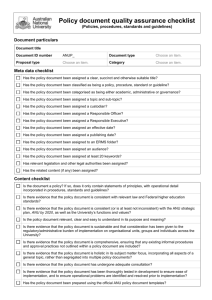Notes: Notes: Notes: Notes: Notes: Notes: Notes: Notes: Notes
advertisement
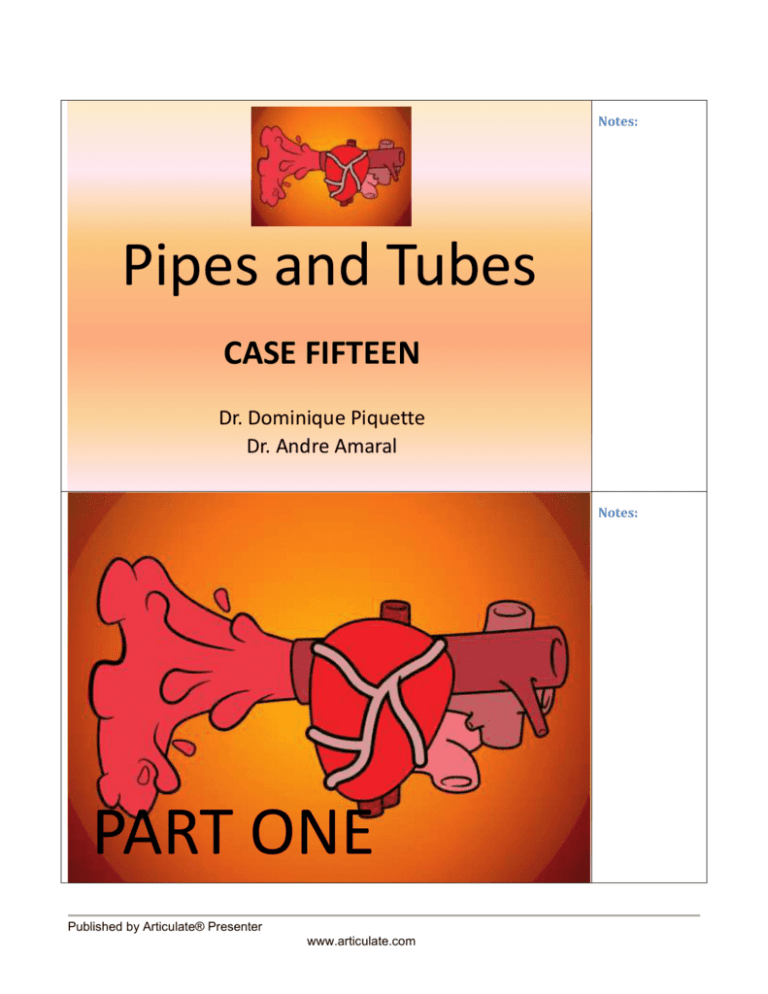
Notes: Pipes and Tubes CASE FIFTEEN Dr. Dominique Piquette Dr. Andre Amaral Notes: PART ONE Published by Articulate® Presenter www.articulate.com Notes: You are the fellow covering the cardiovascular ICU (CVICU) tonight. While you’re writing transfer orders in a level 2 ICU, you are called to assess a new CV patient who came from the OR after a replacement of his aortic valve and ascending aorta. Unfortunately, you have missed the report from the anesthetist. You get a summary of Mr. Pin’s history by the CV RN: Mr. Pin was seen in the E.R. earlier today with an atypical chest pain. A CT scan with contrast was done, revealing an extensive type A aortic dissection. The patient was briefly brought to CVICU before his surgery and quickly seen by your colleague. He wrote an admission note… Published by Articulate® Presenter www.articulate.com Notes: Notes: CVICU – Admission Note 74 y.o. PMHx : HTN Dyslipidemia DM type 2 x 8y CRF creat=110 in old chart Hypothyroidism Home Rx: fosinopril / amlodipine / HCTZ / crestor / metformin / synthroid NKDA Ex-smoker : d/c 15y ago – No EtOH Notes: Hx : Patient admitted with atypical CP 36h ago, non specific ECG changes (T waves inversion), and mildly positive trops (0.13). Initially query of PE so PE study completed no PE but suspicion of type A Ao dissection…. CT completed to confirm dx. BP initially 140/85 with HR 90/min so IV labetolol started but dropped BP in E.R. and on levo 4mcg/min for MAP 65 on arrival to CVICU. No echo done. Published by Articulate® Presenter www.articulate.com Notes: N: CV: Pt alert and oriented MAP 62 on levo 4 HR 85 (sinus) ECG: no ST elevation / latest trops 0.17 FiO2: 4L/min Chest : clear x 2 X-ray : small left pl effusion ABG : 7.32/32/75/19 Abdo soft U.O. 250 cc x admission Creat 145 lytes OK T 36.4 Hb 110 WBC 11.8 Plt 190 Coag Normal Resp: GI : GU: HI: Impression & Plan: Type A Aortic Dissection – OR pending You have a look at the anesthetic record, and you make the following observations: • • • The pump time was 220 min, with a circulation arrest of 18 min. The patient received 1.5 liters of crystalloids/colloids in the OR, 2 U of RBCs (+ blood from Cell Saver), and 1 pool of platelets. The BP was somewhat unstable when the pt came off pump, requiring the addition of IV epinephrine at 4mcg/min to the drip of levophed already increased at 15mcg/min. The patient is currently on this same amount of pressors. • The initial CI and PAP in the OR (pre-CPB) were respectively 2.4 and 25/12, and the final values (post-CPB) were of 2.8 and 30/16. • The urine output was about 200cc during the case. • The patient had to be defibrillated twice when he came off pump, but was then paced because of a slow junctional rhythm. He’s been paced at 80/min since his arrival in CVICU. There was no spontaneous beat when the pacing rate was decreased to 50/min, so it was left at 80/min. • There is no post-op TEE report, but the RN confirms that the anesthetist said that the valve looked good on the post-op echo. Published by Articulate® Presenter www.articulate.com Notes: Notes: The patient is still sedated from the surgery. His MAP is currently 72 with a paced HR at 80/min. His PAP are 22/12 and his CI is 2.3. The CVP is 8. The ECG shows diffuse ST elevations in the anterolateral leads. The patient is on a FiO2 of 50%, fully vented. The chest tubes have drained 130cc in the last 40 minutes. The abdomen is soft. The U.O. is limited. The post-op blood work shows: Blood Gas Type pH pCO2 pO2 Bicarbonate Saturation FiO2 Blood Gas -Venous pH pCO2 pO2 Bicarbonate Saturation FiO2 Lactates CBC Hemoglobin WBC Count Neutrophils Lymphocytes Monocytes Eosinophils Basophils Platelet Count Hematocrit ARTERIAL 7.25 48 125 17 0.98 0.5 VENOUS 7.22 54 36 17 0.63 0.5 7.35 - 7.45 35 - 45 mm Hg 80 - 100 mm Hg 21 - 28 mmol/L 0.90 - 1.00 6.1 107 15.8 13.3 3 0.6 0.5 0.1 110 0.436 Published by Articulate® Presenter www.articulate.com 115 - 165 g/L 4.0 - 11.0 x 10E9/L 2.0 - 7.5 x 10E9/L 1.0 - 4.0 x 10E9/L 0 - 1.0 x 10E9/L 0 - 0.7 x 10E9/L 0 x 0.3 x 10E9/L 150 - 400 x 10E9/L 0.340 - 0.490 L/L Notes: Notes: Calcium Profile Calcium 1.9 2.20 - 2.60 mmol/L Magnesium 0.75 0.70 - 1.05 mmol/L Phosphate 1.45 0.87 - 1.52 mmol/L Sodium 148 135 - 147 mmol/L Potassium 4.9 3.5 - 5.0 mmol/L Chloride 115 95 - 107 mmol/L CO2 Total 17 22 - 30 mmol/L Glucose- Random 9.6 4.0 - 8.0 mmol/L INR 1.47 0.9 - 1.10 INR PTT 35.0 24.0 - 34.0 SECS Electrolytes Notes: Renal Profile Urea 11.5 3.0 - 7.0 mmol/L Creatinine 153 44 - 106 umon/L 507 < 195 IU/L 3 2- 6 ng/mL <0.01 < 0.05 0.19 < 0.10 ug/L Bilirubin - Total 10 <20.0 umol/L AST 35 <31 IU/L ALT 42 <31 IU/L ALP 130 40 – 120 IU/L CK + CK-MB CK mB Mass mB Mass Fraction Troponin T Liver Profile (Bili/AST/ALT/ALP) Published by Articulate® Presenter www.articulate.com Notes: You decide to administer a bolus of 500cc of RL to the patient with a repeated cardiac index post-bolus. You ask the nurse to titrate down the epinephrine if possible, and hope to be able to wean off the pressors with a bit of extra fluids. Notes: Two hours later, you’re called back at the bedside because the nurse had to go up on the epi that is now at 8 mcg/min. The patient is back in his own sinus rhythm at 110/min. Published by Articulate® Presenter www.articulate.com Notes: The patient is waking up. His chest still sounds clear, and the vent settings are the same. The chest tubes have drained about 120-150cc/h since the admission, but it seems to taper down now. The ECG is unchanged. You administer another 500cc bolus of RL and ask the RN to start some milrinone at 0.25 mcg/kg/min. You send another Hg, coag, and MVBG. Notes: One hour later, you repeat the hemodynamic values: Published by Articulate® Presenter www.articulate.com The following blood work comes back: Blood Gas -Venous pH pCO2 pO2 Bicarbonate Saturation FiO2 Notes: VENOUS 7.28 43 31 16 0.56 0.5 Lactates 4.8 CBC Hemoglobin WBC Count Neutrophils Lymphocytes Monocytes Eosinophils Basophils Platelet Count Hematocrit 101 15.3 13.5 3 0.6 0.5 0.1 95 0.418 115 - 165 g/L 4.0 - 11.0 x 10E9/L 2.0 - 7.5 x 10E9/L 1.0 - 4.0 x 10E9/L 0 - 1.0 x 10E9/L 0 - 0.7 x 10E9/L 0 x 0.3 x 10E9/L 150 - 400 x 10E9/L 0.340 - 0.490 L/L Notes: Doctor, I am sorry but the MAP is still around 57… That is a bit suboptimal… Published by Articulate® Presenter www.articulate.com Notes: Objectives: To diagnose and medically manage an acute aortic dissection. To interpret the hemodynamic values of invasive cardiac monitoring. To anticipate and manage postoperative complications post major vascular surgery. Questions: PROPERTIES Allow user to leave interaction: Show ‘Next Slide’ Button: Completion Button Label: Anytime Show upon completion Next Slide - How would you have optimized the medical management of this patient BEFORE the surgery? - Which information from the CT findings may be relevant for the postoperative management? - What happens during an intraoperative circulation arrest? - What are the implications for the postoperative management? - Are you satisfied with the Published by Articulate® Presenter www.articulate.com hemodynamic status of the patient? - Any suggestions in terms of management? Notes: PART TWO Published by Articulate® Presenter www.articulate.com Notes: You ask the anesthesiologist to come do an urgent TEE on Mr. Pin. The echo reveals a hyperdynamic LV with dynamic obstruction of the left ventricular walls. The RV is mildly hypokinetic, but not distended. Its function appears similar to the pre-op echo results. The IVC is still collapsible. Notes: Based on those results, you administer an extra liter of crystalloids, and increase the baseline IV rate at 150cc/h. You also ask the RN to stop the milrinone, cut the dose of vasopressors by a half, except for the vasopressin. You tell her to stop them if no change in the BP occurs within the next 10-15 minutes. Published by Articulate® Presenter www.articulate.com Two hours later, the following values are obtained: Notes: Notes: All the vasopressors are off, except for the vasopressin at 2U/h. You ask the RN to wean it off for a MAP > 65, and head to your call room. Published by Articulate® Presenter www.articulate.com Notes: Two hours later, you get called by the CVICU RN again. The patient has been in atrial fibrillation for the past 20 min at 140/min, and hasn’t convert back to sinus despite an extra bolus of Mg and K for latest blood work values of 0.8 and 3.8 respectively. Should I give amiodarone? Can you repeat a set of hemodynamic values and a MVBG ? I am on my way to the unit. Notes: The results are: Published by Articulate® Presenter www.articulate.com The nurse is now also having trouble to get a wedge value and wonders if we should reposition the PA line. You look at the tracing transduced from the distal port of the PA line and see the following: Notes: Notes: - To recognize, diagnose, and manage dynamic obstructions of the left and right ventricles. - To interpret the hemodynamic value changes according to the clinical management. - To recognize and address the technical issues related to the use of a PA catheter. PROPERTIES Allow user to leave interaction: Show ‘Next Slide’ Button: Completion Button Label: Anytime Show upon completion Next Slide Questions: - What is your interpretation of this tracing? - Are you Published by Articulate® Presenter www.articulate.com concerned about this patient? - What would you do at this point? - What do you expect in terms of short-term and mid-term prognosis? Notes: PART THREE Published by Articulate® Presenter www.articulate.com Notes: You give some amiodarone (bolus and infusion), and decide to restart a low dose of milrinone at 0.250mcg/kg/min. You ask the RN to repeat the hemodynamic values and a MVBG in 2 hours. The nurse calls you back after 2 hours: The patient is now in sinus rhythm, but there are some technical issues with the cardiac output line. Nobody can get a C.O. or C.I. from the PA line. A few nurses have gone through the usual troubleshooting measures, but we can’t find the source of the problem… Oh Dear… I am coming… Published by Articulate® Presenter www.articulate.com Notes: They show you the tracing resulting from the square wave test: Notes: Notes: Questions: - How do you obtain the square tracing? - Is this an expected tracing for a square wave test? PROPERTIES Allow user to leave interaction: Show ‘Next Slide’ Button: Completion Button Label: Anytime Show upon completion Next Slide Published by Articulate® Presenter www.articulate.com - What is the latest part of the tracing indicative of? Notes: The rest of the values obtained are as follow: Notes: Questions: - Are you aware of another way to estimate the cardiac output based on these values? - How reliable is this strategy compared to PA catheter CO measurements? - What is the square wave test? PROPERTIES Allow user to leave interaction: Show ‘Next Slide’ Button: Completion Button Label: Anytime Show upon completion Next Slide Published by Articulate® Presenter www.articulate.com - How do you interpret the results? Notes: References Kamalakannan, D., Rosman, H.S., Eagle, K.A. Acute Aortic Dissection. Crit Care Clin. 23 (4), 779-800 (2007). Tsaii, T.T., Nienaber, C.A., Eagle, K.A. Acute aortic syndromes. Circulation. 112, 3802 (2005). O’Quin, R., Marini, J.J. Pulmonary artery catheterization: Interpretation of tracing. Am Rev Respir Dis. 128 (2), 319 (1983). Pinsky, M.R. Pulmonary artery occlusion pressure. Intensive Care Med. 29, 19 (2003). RCPSC OBJECTIVES 6.2. Cardiovascular Dysfunction 6.2.1. The ability to recognize the problem, provide emergency life support, and embark upon a diagnostic and management program. 6.2.2. Demonstrate knowledge of: 6.2.2.2. the principles of invasive and noninvasive hemodynamic monitoring 6.2.2.3. the pathophysiology and treatment of cardiac failure, including the pharmacology of drugs used to treat these entities 6.2.2.4. basic and complex cardiac arrhythmias, including pharmacological and electrical management 6.2.2.5. shock syndromes, with emphasis on the pathophysiologica l events leading to and resulting from the shock state 6.2.2.7. surgical interventions in patients with cardiac disease, including Published by Articulate® Presenter www.articulate.com perioperative management of the cardiovascular surgery patient Published by Articulate® Presenter www.articulate.com

